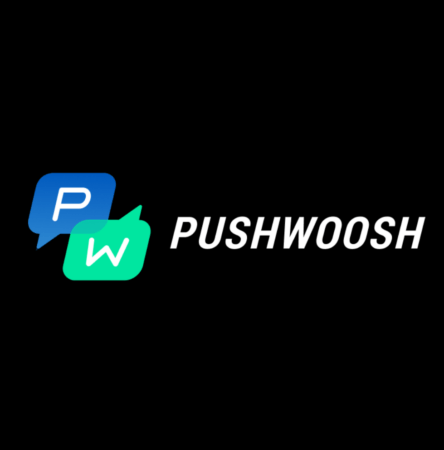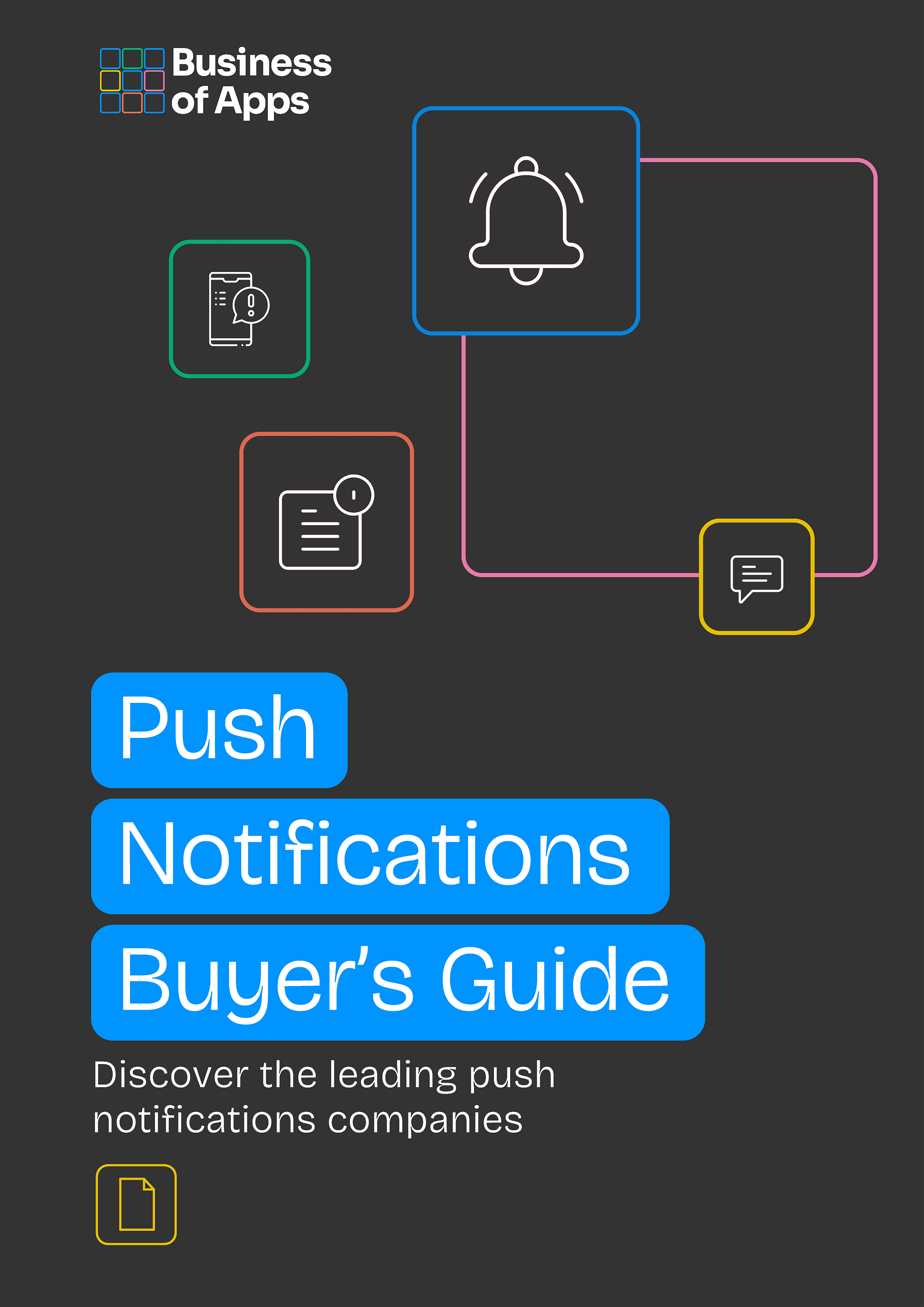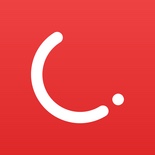Push notification services offer fast, real-time, targeted messaging that boosts click-through rates and increases app retention scores.
To get results, app owners must strike a fine balance – send too many and users tune out. Don’t send enough and they’ll forget about you. And this is why app companies go to push notification services, like tech platforms, for help.
Statistics suggest almost half of users stay engaged on an app when they opt into push notifications. Or, at least beyond the unofficial retention point of 11 sessions. But research conducted by Leanplum in 2019 also showed more than 75% of millennials delete an app if they get too many.
So, to help you get a handle on this, we’ve compiled a list of top push notification services to consider approaching. And as part of our guide, we’ll answer the question ‘what is a push notification’ and show you what they can do for your business.
Streamline your push notification campaigns
One engine for highly personalized, segmented messages, and analytics
Learn moreWhat are push notifications?
A mobile push notification is an automated message sent to a device via an app. They’re like SMS but only reach users who’ve installed the app. And this gives users more control over what they receive. Rich push notifications are also a type of push notification that contain rich media attachments like GIFs or videos.
And both types encourage users to log back into an app, even when the app is closed.
Push Notifications Buyer's Guide
Download our Push Notifications Buyer’s Guide to get a full list of the best service providers on the market to choose from. Also, learn what push notifications are, how to choose a provider, and about main categories of push notifications providers.
First launched by Apple APNS (Apple Push Notification Service) in 2009, push notifications are a feature of every operating system, from iOS and Android to Fire OS and Windows. Marketers can use them to encourage app use in different ways, provided users give their consent to do so.
So what’s the key to creating a push notification strategy that gets engagement?
Well, analysis shows that sending frequent push notifications during an app user’s first 90 days boosts retention by X3 to X10. And the same research showed an 80% retention rate on Android platforms in the first week. For iOS users, retention rates were as high as 90%.
So while Android gets very high opt-in rates over iOS, it’s because it sends messages by default. For iOS users, they must give their consent to receive any push notifications.
Featured Push Notifications Services
The best push notification services
Push notification services are a way for mobile apps to send updates, alerts, and messages to users even when the app isn’t open.
When a user gives permission, the push notification service sends a message to the user’s device, which appears as a notification (or badge) on the home screen.
The feature is commonly used by social media apps, news apps, and eCommerce websites to keep users engaged (and informed) about important updates and events.
We’ve listed the best push notification services below.
1. Airship
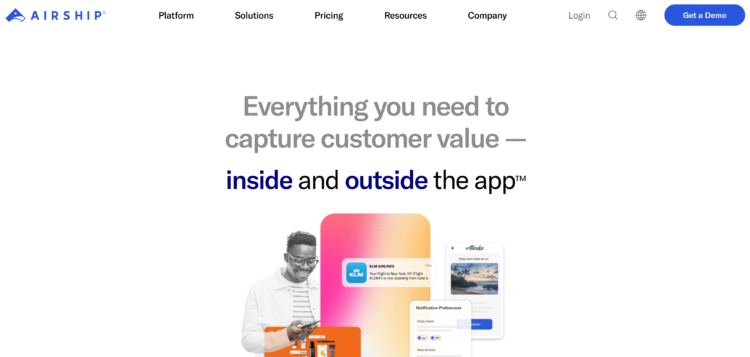
Airship is a platform that helps businesses to engage with their customers through mobile messaging. It allows you to send targeted and personalized messages, such as push notifications, in-app messages, and SMS, to your customers based on behavior and preferences.
Businesses can also track the performance of campaigns, measure customer engagement, and optimize their messaging strategy to improve customer experience and drive revenue.
Overview
Airship was founded in 2009 by Blake Schreck, Adam Lowry, and Michael Richardson under the name “Urban Airship.” The company started as a mobile app development platform but later shifted its focus to mobile messaging and rebranded itself as “Airship” in 2019.
Today, Airship is a leading provider of mobile marketing solutions, serving thousands of customers worldwide.
Services
Airship provides its customers with the following services:
- Mobile messaging solutions that help businesses send targeted and personalized messages to their customers via push notifications, in-app messaging, SMS, and email
- Automation tools that enable you to create automated messaging workflows based on customer behavior
- Real-time insights into the performance of mobile messaging campaigns, allowing you to optimize your messaging strategy
2. OneSignal
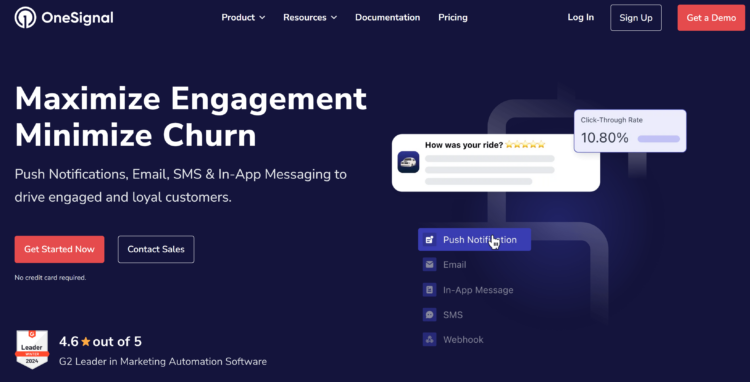
OneSignal is a powerful customer engagement platform that enables businesses to send targeted messages, push notifications, and SMS to their users. It offers a wide range of features, including audience segmentation, A/B testing, automation, and real-time analytics.
With OneSignal, businesses can reach their audience across multiple channels and devices, and deliver personalized experiences to their users. It’s widely used by businesses of all sizes, from startups to enterprise-level organizations.
Overview
OneSignal was founded in 2014 by George Deglin, Long Vo, and Zack Hendlin. They wanted to help businesses improve their customer engagement by providing a simple and effective platform for sending push notifications.
Since then, OneSignal has grown rapidly and has become one of the leading customer engagement platforms in the market today. It’s used by thousands of businesses around the world, including some of the biggest names in tech, media, and eCommerce.
Services
OneSignal provides its customers with the following services:
- Allows businesses and organizations to send targeted and personalized messages to their users on desktop and mobile devices
- Provides a simple and easy-to-use dashboard that allows you to create and send push notifications to specific segments of your audience based on their behavior, preferences, and location
- Provides real-time delivery and open-rate tracking, as well as A/B testing capabilities to help optimize your messaging strategy
3. The Sender
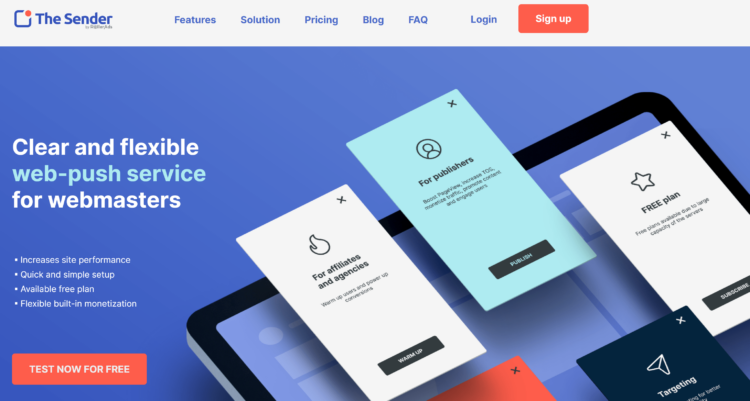
The Sender is a push service that enables app developers and website owners to send push notifications to their users. The service provides a simple and reliable way to send notifications to mobile devices without requiring developers to manage complex infrastructure (or maintain their own servers).
The Sender offers message targeting, analytics, and personalization, allowing you to send relevant and timely notifications to your users.
Overview
The Sender is part of RollerAds, a digital advertising platform that provides push notifications, pop-up and pop-under ads, and native ads.
It was founded in 2018 by a team of experienced advertising professionals with the goal of creating a user-friendly and effective advertising platform for businesses of all sizes.
Services
The Sender provides its customers with the following services:
- Clickable notifications that appear on a user’s device screen, even when they are not actively using the app or browsing the website
- The ability to use push notifications to promote new products, sales, or offers
- In-depth analytics and income-generating monetization with scheduling and automation
4. AdMaven

AdMaven’s push notification service allows publishers to monetize their traffic by displaying targeted push notifications to their users. AdMaven’s push notifications are designed to be non-intrusive and can be easily customized to match the publisher’s design.
Publishers can earn revenue by displaying push notifications to their users, while advertisers can use AdMaven’s push notification service to promote their products or services to a large audience.
Overview
AdMaven was founded in 2015. The company is headquartered in Tel Aviv, Israel, and has offices in Ukraine, India, and the UK.
Since its founding, AdMaven has grown to become one of the leading online ad networks, serving over 10 billion ad impressions per month and working with thousands of publishers and advertisers around the world.
AdMaven’s push notification service is one of the company’s newest and most innovative products.
Services
AdMaven provides its customers with the following services:
- Standard push notifications that are designed to be non-intrusive and can be customized to match the publisher’s design. They are delivered to users even when they are not actively using the app, ensuring maximum visibility and engagement
- Native push notifications which are designed to blend seamlessly with the look and feel of the app. They are delivered directly to the user’s device and can be customized to match the user’s preferences
- In-page push notifications that are designed to appear inside the publisher’s website rather than as separate notifications
5. PropellerAds

PropellerAds Push Notifications is one of the advertising formats offered by the platform. It’s a type of ad that appears as a small notification on a user’s device, typically in the corner of their screen. When the user clicks on the notification, they are taken to the landing page for the product or service being advertised.
Advertisers can use Propeller Ads’ push notifications to reach a large audience and drive traffic to their landing page. The platform offers targeting options such as location, device type, and browser to help advertisers get their message in front of the right audience.
Overview
Propeller Ads was founded in 2011 by CEO Dmitry Yudin. The company is based in Limassol, Cyprus, and has additional offices in India, Ukraine, and Russia.
Since its founding, Propeller Ads has grown to become one of the leading digital ad companies, with a global reach of over 1 billion users and partnerships with major advertisers and publishers around the world.
Services
PropellerAds provides its customers with the following services:
- Advertisers can bid in real time for ad space, allowing them to reach their audience at the right time and place
- The platform offers advanced targeting options such as location, device type, browser, and more
- You can customize your push notifications with their own branding and messaging
6. Braze

Braze is a marketing platform that helps brands build relationships with their customers by providing personalized messaging experiences across various channels, including email, push notifications, and messaging apps.
The platform’s (AI-powered) tools allow businesses to better understand their customers and deliver targeted messages that drive engagement and loyalty.
Overview
Braze, formerly known as Appboy, was founded in 2011 by Bill Magnuson and Jon Hyman. The company is headquartered in New York City.
As of 2021, Braze serves over 1,000 customers worldwide, including leading brands such as Burger King, Delivery Hero, Domino’s, HBO, and Udacity.
Services
Braze provides its customers with the following services:
- Personalized messages to customers across multiple channels, including email, push notifications, messaging apps, and more
- The platform enables businesses to quickly segment their audience based on various attributes, including demographics, behavior, and engagement history
- Braze offers a range of automation tools that allow businesses to create and trigger messages based on specific actions, such as cart abandonment and app uninstall
7. CleverTap

CleverTap is a customer engagement (and retention) platform that helps businesses understand user behavior, personalize engagement, and drive growth.
The platform provides a range of features, including user segmentation, behavioral analytics, A/B testing, and personalized messaging to help businesses engage with their customers.
Overview
CleverTap was founded in 2013 by Sunil Thomas, Anand Jain, and Suresh Kondamudi. The company is headquartered in Mountain View, California, and has offices in Mumbai, Singapore, and Amsterdam.
CleverTap has become a leading customer engagement and retention platform used by thousands of businesses around the world.
Services
CleverTap provides its customers with the following services:
- Enables app businesses to segment users based on their behavior, demographics, and other criteria to gain insights into their needs, preferences, and behaviors
- Provides detailed behavioral analytics to help you understand how users interact with your app and identify opportunities for optimization
- Enables brands to test different variations of their engagement strategies to determine which one performs better
8. MoEngage

MoEngage is a customer engagement and retention platform that allows brands to deliver personalized (and contextual) messages across multiple channels like mobile push, email, in-app, web push, SMS, and more.
The platform uses automation to help businesses understand their customers better and engage with them. MoEngage also provides real-time analytics and insights to help brands measure the effectiveness of their campaigns and optimize their customer engagement strategy.
Overview
MoEngage was founded in 2014 by Raviteja Dodda and Yashwant Kumar. The company is headquartered in San Francisco, California, with offices in Bangalore and Berlin.
MoEngage has a diverse range of clients across industries such as eCommerce, finance, and travel. Some of their key clients include Ola, Flipkart, McAfee, Samsung, Deutsche Telekom, and Airtel.
Services
MoEngage provides its customers with the following services:
- The platform uses automation to help businesses deliver the right message at the right time to the most suitable customer
- Push notification services include personalization, segmentation, automation, and real-time analytics
- Businesses can leverage MoEngage’s deep linking capabilities to drive higher engagement and conversions from their push campaigns
9. MessageGears

MessageGears (former Swrve) is a mobile marketing automation platform that helps businesses engage with their app users. It offers a variety of tools for creating personalized push notifications, in-app messages, and other types of content that can be targeted to specific segments of users based on their behavior and preferences.
MessageGears also provides analytics and A/B testing capabilities to help businesses optimize their mobile marketing campaigns.
Overview
MessageGears was founded in 2010 by Hugh Reynolds, Steve Collins, and Sean O’Sullivan. The company is focused on helping businesses build long-term relationships with their customers by providing personalized and relevant content that meets their needs.
MessageGears’s key clients include some of the world’s leading brands across a range of industries, including Sony Pictures Television, Condé Nast, Ryanair, Emirates, and Playrix.
Services
MessageGears provides its customers with the following services:
- A/B testing capabilities to help businesses optimize their mobile marketing campaigns and improve their performance
- Offers advanced analytics and reporting features to help businesses track the performance of their mobile marketing campaigns and gain insights into their app users’ behavior
- Allows brands to create personalized experiences for their app users by delivering relevant content based on their preferences and behavior
10. Iterable

Iterable is a customer communication platform that helps brands deliver experiences with individualized communications at scale. Marketers can create, optimize, and measure the interactions taking place throughout the entire customer journey.
Iterable boasts users among brands such as Fender, Calm, and Box, who build customer-centric experiences by delivering the right content to the right audience at the right time.
Overview
Andrew Boni co-founded Iterable in 2013 and has served as CEO since 2021. Prior to Iterable, Andrew worked on Google’s Strategic Partnerships team. He graduated with a B.S. in Computer Science from Boston College.
Notable clients include Airtable, Rover, and DoorDash.
Services
Iterable provides its customers with the following services:
- A cross-channel marketing platform that offers push notifications, email, in-app messaging, and more
- Allows brands to scale with a high level of customization
- Enables marketers to leverage real-time user, demographic, behavioral, and custom event data to instantly trigger campaigns
11. WonderPush

WonderPush is a push notification service that helps businesses engage with their customers through personalized messages. Using the platform, businesses can easily create and send targeted push notifications to their customers’ devices, ensuring that their message is received at the right time and place.
The platform also provides detailed analytics to help businesses track the performance of their campaigns and optimize their outreach strategy.
Overview
WonderPush was founded in 2016 by Vladimir Dimitroff and Thomas-Samuel Arnet. The platform has raised $2.7 million in funding as of its latest funding round.
They have a wide range of clients from different industries, including eCommerce, media, and gaming. Some notable clients include Deezer, Rakuten Viber, Cdiscount, and BlaBlaCar.
Services
WonderPush provides its customers with the following services:
- You can send personalized push notifications to your customers based on their behavior, interests, and location
- A/B testing capabilities, allowing businesses to test different push notification strategies to see what works best for their audience
- You can set up automated push notification campaigns based on triggers such as user behavior, time, and location
12. Pushwoosh
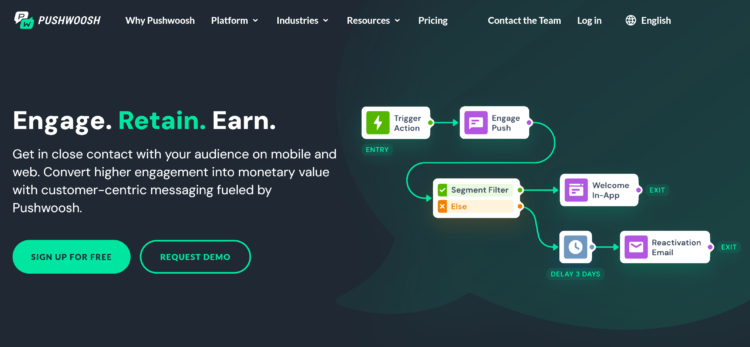
Pushwoosh is a push notification service that enables businesses to send push notifications to their customers. It provides a platform for businesses to manage and personalize their push notifications, track user engagement, and analyze the effectiveness of their campaigns.
Pushwoosh supports multiple platforms, including iOS, Android, and Windows Phone, and offers features such as audience segmentation, in-app messaging, and push notification automation.
Overview
Pushwoosh was founded in 2011 by Max Konev. The company is headquartered in New York City.
Pushwoosh has grown to become a leading push notification service, serving businesses in more than 170 countries around the world. Its mission is to help businesses engage with their customers and drive conversions through targeted and personalized push notifications.
Services
Pushwoosh provides its customers with the following services:
- Allows businesses to send push notifications to their customers’ mobile devices or browsers, whether they are using iOS, Android, Windows, or macOS
- In-app messaging service that allows businesses to send targeted messages to their customers while they are using their app
- Web push notification service that enables brands to send push notifications to their customers’ browsers, whether they are using desktop or mobile devices
13. Amazon SNS

Amazon SNS (Simple Notification Service) is a fully managed messaging service that enables you to send notifications from the cloud. With Amazon SNS, you can send messages to various endpoints such as email, SMS, mobile push notifications, and more.
It’s a highly scalable and cost-effective service that makes it easy to build distributed apps and microservices that can communicate with each other through messaging and notifications.
Overview
The service was launched on April 8th, 2010, by Amazon Web Services, which is a subsidiary of Amazon.com. AWS is a cloud computing platform that provides a wide range of services to individuals, companies, and governments.
Amazon SNS is one of the many services provided by AWS. It was created to help developers build scalable, flexible, and reliable apps that can send notifications to users, devices, and other apps.
Services
Amazon provides its customers with the following services:
- You can send push notifications to mobile devices, including iOS, Android, and Amazon devices
- Amazon SNS allows you to send SMS messages to mobile devices in over 200 countries and territories
- You can use Amazon SNS to send email notifications to any email address
Types of app push notifications
So what are some examples of push notifications we can show you?
- Pop-up alerts: Pop-up alerts are real-time updates like news items, event updates and calendar reminders. And stats show that too many can lead to 10% of users disabling notifications and 6% disabling apps.
- Progress notifications: Training, gaming and learning apps use push notifications to encourage users to keep logging into an app.
- Promotional notifications: Online retailers often send exclusive offers, deals and giveaways to customers. For example, grocery app Perekrestock achieved a 19X higher conversion “Add to Basket” conversion goal using push notifications providers.
- Geo-location notifications: Geotargeting lets marketers send location-based weather alerts or commercial offers as part of a mobile marketing strategy.
- Delivery status tracking: E-commerce brands use push notifications to keep customers updated on parcel deliveries.
- Payment confirmations: Customers can receive instant transactional updates via push notification.
- Abandoned cart reminders: In March 2021, abandoned cart levels were as high as 80% for all sectors. And push notifications were effective at reminding customers of what they left behind.
What do app push notification services do?
Push notifications providers have been around for a while and some for over a decade. Amassing a huge amount of expertise, a push notification platform or company can make it easier to plan, schedule and deploy messaging to users.
Statistics show app users respond best to personalized, relevant and appropriate messaging. And a push notification platform, API or marketing company can offer many attributes that make them worth partnering with.
Some features they offer include:
Automated messaging
Sending irrelevant notifications results in up to 60% attrition. And this makes relevancy an important factor of your push notification strategy.
A push notification platform can help with creating strategies that target users based on behaviors, demographics and geographic locations. And they can set up automated messages to service these strategic aims on your behalf.
Using automation saves considerable time and resources and helps you reach campaign goals much faster.
Cross-channel strategies
Push notifications have an impact when they bounce off other forms of messaging. After all, they’re there to ‘push’ users to open an app. So, it’s likely you’ll need further communications strategies to hold users’ attention and keep them engaged, once you’ve got them in the app.
A push notification platform can also help to develop in-app messaging services that engage users at the most sophisticated level. And with more agility to focus on personalized or customized messaging via in-app messaging services, push notifications providers can enable omnichannel marketing strategies that impact customer behavior on many levels.
Abandoned shopping cart boost
Figures from Statista show the main reason for high cart abandonment rates is extra costs such as shipping and taxes. But you can address these issues through push notifications by highlighting relevant options and allaying customer concerns.
Using a push notification platform in a strategic and targeted way can help to prevent the risk that customers leave their goods on hold to check out the competition.
Why should you use push notification services for your mobile app?
We’ve already highlighted the key ways you can use push notification services to enhance mobile push notifications. But what are some of the best reasons for connecting with these providers?
Promote feature adoption
It’s accepted that most users won’t use every feature of an app. But using a push notification platform can help to encourage feature discovery and adoption.
And once users are engaging with unused features, studies suggest it can lead to increased engagement and retention levels. Plus, when users feel they gain value from an app, their loyalty increases.
Support Deep Links to specific areas
Adding deep links to push notifications can help to guide users toward specific features of an app. And this can also increase feature adoption.
But reports also suggest that adding deep links improves the user experience, promotes retention and increases conversions by 70%.
So, deep links can help app owners to be more specific and targeted in their strategic approach. And it’s a push notification platform or service that can form the basis of doing that.
Boost revenue
Statistics suggest that 50% of users find push notifications useful, but only when they choose to receive them.
Enhance omnichannel experiences
Retailers have an opportunity to maximize omnichannel marketing experiences using rich push notifications to promote flash sales, new products or in-app promotions.
And despite their ability to increase reaction times by 25% and boost open rates by over 50%, less than 10% of marketers use rich push notifications as part of their strategies.
But with their expertise, knowledge and state-of-the-art services, savvy app companies can look to push notification services for help.
How do app users respond to push notifications?
So how do users respond to push? Well, stats show they can impact a wide number of rates. And these make up some solid extra reasons why it’s a good idea to find a push notifications provider to work with:
- Open rates: A 2021 report revealed open rates of 3.4% for push notifications on iPhone and 4.6% on Android. And Airship’s push notifications statistics show that tailoring sending times for each user will boost open rates by 40%.
- Reaction rates: Targeting user segments can increase reaction rates by 3X. And offering personalized messages will gain 4-fold increases in response.
- Retention rates: Almost 50% of those who don’t enable push notifications end up disappearing after two sessions. And stats from Leanplum show correct timing leads to a 7x lift in retention.
- Conversion rates: Generic messages sent at the wrong times don’t tend to convert customers. But timing and personalization will have an impact.
- Types of app: Among a poll run by VWO Engage, social media and news apps were the favorite types for receiving push notifications.
- Open rates on verticals: The best performing verticals for open rates are business & finance, entertainment & events and health & fitness.
Choose the best push notifications providers
So how should app owners select the best push notifications providers to help with optimizing app growth, installs and conversions?
With many different factors to consider, you can start by determining campaign goals and outlining the purpose of your push notifications.
For example, is it more important to promote engagement, conversions or retention? Or do you want to include open rates and conversion rates?
It’s worth taking some time to review your current situation, where you want to be and the kind of benefits you want to target before selecting a provider. But also, when factors such as the no. of notifications, the timing of delivery, the type of operating system and the need for personalization carry significant weight, app owners should be discerning.
For instance, basic personalization improves open rates by almost 10%. And adding emojis can boost CTR by almost 5%. And these are all aspects that can be factored into a test-and-learn approach using push notification services.
So, to get the most out of your strategy, it’s important to choose the right push notifications providers. But which ones are the best?
The top push notification providers come in a few shapes and sizes. Breaking them down into three main categories, it’s worth reviewing the different types to help decide which one would work best for you.
Platforms
A push notification platform is a one-stop-shop for driving engagement, communications and conversions. You can schedule personalized messaging and connect it to in-app messaging, but also send out notifications at speed.
It’s also convenient to integrate a push notification platform with other tools to create more impactful campaigns. Plus, many specialize in particular areas like e-commerce. Most of them support multiple rich formats and offer analytics reports and tech or account management support.
Marketing companies
Several marketing companies offer in-app plugins that include push notifications. Working in a consultative way, they support app owners with the tools they need to design and build omnichannel experiences.
Some specialist areas include deep linking tech support, geotargeting, analytics and recommendations on the best times to send push notifications.
Push notifications APIs
Like a push notification platform, push notifications APIs offer a SaaS tech solution for companies to use. But they do differ in the way they help developers avoid the hassle of complex integrations with other platforms. Plus, they allow them to manage real-time push updates.
Many APIs run on pay-as-you-go models or exclude upfront costs, which can be helpful when running push messaging for the first time.
Work with top push notification services
So, that’s our guide to finding the best push notification services for your business. Make sure you consider your campaign goals before you make your selection. And think through which stage your business is at and what you want to gain from conducting push notifications activity.
Once you’re clear on that, then take a look through our complete list of providers below.


